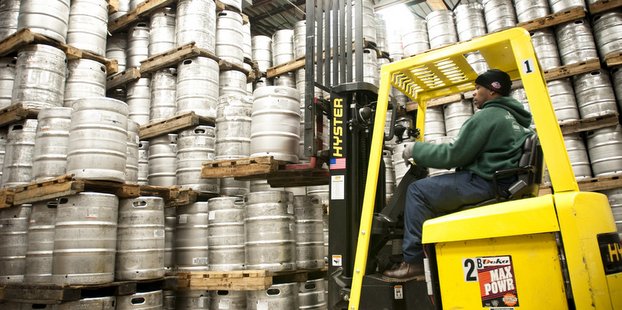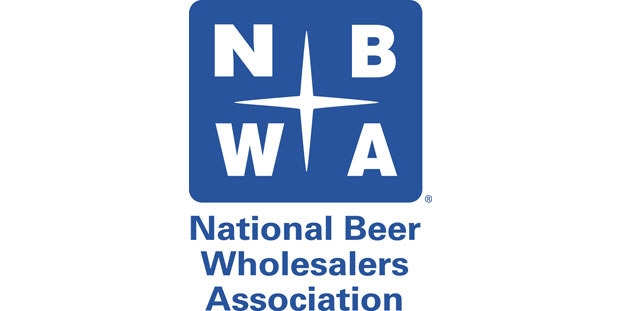
Craft brewing is a unique industry in America, not just for its creative, bold products, but also because of the regulation of its distribution and sales, which keeps alive its independent, local spirit amid intense monopolistic forces.
Just how important is wholesale distribution to craft beer? For starters, it was a key in ending Prohibition. Many blamed the deplorable state of the alcohol industry and consumption pre-Prohibition on vertical integration. After it became clear that banning alcohol sales was no answer, the 21st Amendment was constructed and a key tenant was the establishment of a third tier that kept alcohol producers from selling directly to the public or retail outlets. Voila, distribution saved alcohol in America. Fast forward to 2013, and it is still a key factor in spreading the wares of more than 2,500 craft beer producers in the country.
A report by the Markets, Enterprise and Resiliency Initiative of the New America Foundation in 2012 drove this point home, noting that brewing is at least somewhat protected by true monopoly thanks to its three-tier distribution system. The effectiveness of this system and its enforcement across the country definitely varies, and some might argue that through deregulation efforts and loopholes, the system hasn’t lived up to its real promise to prevent the total dominance of Big Beer. But, the point is, as many loopholes as Big Beer has found in the system to try to vertically integrate and own all of the shelf space, that three-tier system is still alive and pushing independent, small businesses (more than 2,500 now) to a new level of cultural prominence. Compare that to the prospects of developing and retailing other consumer goods on a similar scale. As the New America report puts it:
In most consumer goods markets in America today, two or three giants dominate — think toothpaste, eyeglasses and soft drinks. New entrants—be it Tom’s toothpaste or Vitamin Water — can find it very hard to keep their independence for long. In large part, this is because most distribution systems — and even most shelving decisions inside the retailers — are managed by the giants.
In the beer market, by contrast, new entrants still find more than 3,000 small distributors that have both an interest in promoting new and better products and the means to do so. In this one instance at least, a market designed to yield a particular set of moral outcomes has also proved to be extremely effective at promoting innovation and variety.
“If you look at the success of craft, it’s because distributors have been embracing it,” said Craig Purser, president and chief executive officer of the National Beer Wholesalers Association (NBWA). “When you look at the five year roll of craft as a category, it’s remarkable. It’s been the growth segment of the industry. When you look at beer as a product, it’s sold through an independent distribution network. It’s not an exclusive network. It’s a network where there is incredible access to market. And we’re seeing distributors being very competitive when it comes to obtaining the rights to these brands and being aggressive and active as it relates to getting placement and distribution points at retail and growing both on and off premise.”
Establishing the market
As mentioned earlier, the number of craft brewers is now above the 2,500 mark and there is no indication that will slow down soon. With so many breweries, and so many more on the way, is there enough shelf room for everyone? Can craft-friendly bars keep track of which brands to keep in stock?

In Ohio, few local beer sellers have done more than the Winking Lizard in promoting craft beer. John Lane, vice president of operations, has been at this for close to 20 years, even incorporating a retail wing in a few locations (called Lizardville) and trying out a new concept, Winks, that is more specifically focused on local and regional brands. Lane worked more with the suppliers than distributors in growing Winking Lizard, but these last few years, that has become harder to do.
“Five years ago, I could tell you every single brewery. Now, with 500 more coming on and 1,200 on the drawing board, it’s tougher and tougher,” he said. “With all these new breweries popping up and different ones coming in, I can’t always keep up on that. The distributor is now contracting with smaller breweries, and then they contact me, say they are in the market and request a meeting.”
Many of the distributors he is dealing with, despite the share of Anheuser-Busch InBev and Miller-Coors aligned wholesalers, are independent distributors because they jumped on the trend early and now have the rights to such craft names as New Belgium, Stone, Dogfish Head, Founders, Brooklyn, etc.
“I’m very lucky that it’s broken up a little bit. It is a good thing because when there are too many brands under one house they might not get the attention they really deserve,” he said.
First rule of distribution: Know thy self
Lane is cautious when dealing with smaller and newer breweries. Much of that caution comes from production questions, whether that up and comer will be able to keep up with the new demand and keep up with a consistent product. The distributor becomes your promoter and pusher in the field, taking on business responsibilities that would be a huge challenge for a small brewer to handle themselves, but the main responsibility for managing this expansion and aligning it with production still rests on the brewer.
“The distributor usually has years of experience in that marketplace and they know better than anybody what brand or product will sell with what account,” Purser said. “They will understand the accounts that are more volume focused, and then they will know about emerging retail accounts that will be focused on hand selling and be centralized around choice and variety.”
It is on the brewer to know which of those they want, what they can handle.
Study the market(s) you are looking at, both in terms of potential accounts, the current competition, the best available distributor partner and the five to 10 year outlook. Have a sales projection. See which distributor’s philosophy, style or portfolio matches your brand. Internally, know your pricing and shipping costs. Have your promotional plans ready.
“When they come into a marketplace a distributor will say we’ve got 1,100 accounts and we can have you in 100 of those in X number of days, and the response from the brewer is, ‘Well, thanks, but we only want 30 accounts and here is the list of them,’” Purser said. “It’s a different dynamic, but it’s something where I think the recipe and resolve of the two working together is awesome.”
That effort to gain knowledge in the market doesn’t go unnoticed. In fact, a lack of that research stands out:
“The market is constantly changing and evolving. In craft beer, this happens at a remarkably fast pace and if you aren’t keeping up with the demands/growth of the market, you can see demand outpace supply very quickly. We work hard to keep beer in stock and out to our fans,” said Chad Heath, sales director for Southern California at Stone Brewing“Sometimes they expect me to know about their brewery more than they know about who they are trying to sell to,” Lane said. “I try not to gauge them the first time I meet them, because I don’t think that’s fair either, everyone can have a bad day, but I think not knowing about the customer they are trying to sell to before the walk in is a big red flag. When they make a presentation, they need to know where they should go in your restaurant.”
Lane points to production over and over. Can a 5,000-bbl brewer keep up with this placement? This question was part of the drive behind his retail Lizardville concept. He can now take a flier on a new brand, give them some shelf space in the Lizardville, see how it sells and how it is able to meet demand. From there, it might move into bottles into the Winking Lizard bar or maybe a rotating tap.
“Years ago, with the next tier of breweries — Troegs, Founders, Southern Tier, etc. — I started them out small and put them in a store or a rotating handle like our hoppy hoppy handle, and then as their breweries grew and they were able to produce more, I gave them a permanent handle in like seven stores. We kind of grow it that way rather than just killing them right off the bat because you just can’t do that. You can’t let them bite off more than they can chew.”
Chad Heath, sales director for Southern California at Stone Brewing, said keeping up with demand is the No. 1 mistake brewers make when expanding distribution.
“The market is constantly changing and evolving. In craft beer, this happens at a remarkably fast pace and if you aren’t keeping up with the demands/growth of the market, you can see demand outpace supply very quickly. We work hard to keep beer in stock and out to our fans,” Heath said.
The next, most common mistakes Heath sees are the lack of a true marketing plan and miscalculating the amount of kegs needed to support a single tap handle.
“Cooperage is expensive and the further you sell away from your brewery the more kegs you will need in the field to support a single handle,” he said.
The distribution relationship
We stress again the importance of due diligence with both the market and the potential distribution partner:
- Will they carry your entire product line?
- Do they have refrigeration space for you?
- Will you have a specific brand manager?
- Will this agreement work five years from now, or is it just for this specific area and this moment?
“There’s a great deal of selectivity that takes place by both partners. No distributor wants a product that doesn’t work for them,” Purser said. Some questions the distributor will be asking you or himself:
- What do you envision for this product?
- Do you envision something widely available or more selective?
- How does it specifically lay out in a particular on-premise account?
- What is its relationship with other products?
- What distinguishes it in the marketplace?
- What is the relationship with food?
Lane said to pay attention to pricing.
“I think it’s a disservice when you have the middle guy controlling pricing, and they just line up all their craft breweries at the same price level,” he said. “That makes no sense to me, whatsoever. You’re not looking at the style, how large the brewery is, what it can produce or what their economics are. A lot of the time that will leave a bad taste in my mouth.”
Stone started brewing in 1996 and started self-distributing immediately, Heath said, out of necessity, not luxury. Since that time, Stone has grown that aspect of its business and now distributes for more than 30 craft brewers within its footprint.
“Because we are a craft brewery, we focus all our efforts on how to sell the right beer to each account. Craft beer isn’t about stacks to the roof; it is about educating business owners on the benefit of craft and how they can use craft beer to reach a new audience by selling better, more profitable beverages,” he said. “Our fleet of trucks is 100 percent refrigerated, and we keep our beer refrigerated at all times. This is unique for any wholesaler. Kegs are usually kept cold, but cases are a mixed bag. We treat all craft beer the way the brewers want it to be treated.”
In this role, Stone has a closer look into the issues that distributors deal with.
“This is a heavily controlled and regulated industry, and the Alcohol Beverage Commission [ABC] restricts discounting or deal making in the marketplace. We support this and work hard to make sure everyone is playing fair,” Heath said. “We have to use education and the quality of the beer we are selling to change customer’s behaviors. They must trust us to move into the craft beer segment.”
As a craft brewery and small distributor, Stone is picky on who it distributes. The company fields frequent calls from inquiring brands, but he said the top priority for the distribution arm of the company is quality.
“In today’s environment, amazing beer is a requirement, not a luxury, but you also have to be amazing in other areas for us to consider carrying your brand,” Heath said. “There is one mistake almost all new breweries make — entertaining realistic expectations. I’m often asked ‘how big can you get me.’ Distributing a brand is a shared responsibility. It is hard work and breweries need feet on the street to work alongside their distributor.”
Once that initial relationship is established, just like any other good relationship, continual, quality communication is key for sustaining it. Stay in touch with each of your distributors, maybe designating specific sales team members to work with your network and monitor inventory, sales and order projections.
The next craft beer frontiers
We all know the hot spots and saturated craft beer markets out there, but what is next? Where is the next region of the country a growing brewer might want to focus? Purser said they’ve seen a lot of growth in the Midwest, but there was already a fairly deep craft beer culture there. Recently, he has seen growth in “outlier markets” where the craft beer trend has come along slower: Atlanta, Florida and Texas were the three he found most notable right now.
As these new hot spots start to emerge, filled in with new, hot craft beer brands, Purser said they are being aided by some newer independent distributors as well.
“We have seen a consolidation among the distributors, particularly as brewers have combined, driven by economies of scale,” he said. “What we’re seeing now is a number of new distributors coming to market. The cost of entry to distribution is very low. It is a simple regulatory process if you’ve got an ability to help a brewer get to market and you have the knowledge and background. We’re seeing a number of emerging craft-centric or specialty distributors being developed.”
Not to be defeated in this growing category competition, especially as overall beer (read: Big Beer) sales decline, are the larger distributors, some of which are launching craft distribution companies within the larger organization that actually compete and sell against the larger entity.
The consumers are out there; the distribution network exists and might be growing in craft’s favor. From here, it is up to aspiring brewing businesses to, again, know thy selves and craft competent market plans, forecasts and, of course, stand-out beer.
“The beer has to be flawless from day one,” Heath said. “Be unique, be amazing and work hard to build brand loyalty and recognition. Set realistic goals and plan a growth trajectory. But above all else, brew amazing and consistent beer.”





RT @CraftBrewingBiz: Craft beer distribution: http://t.co/fgl7g99jdA Study the market, distributors and your own operations. #sundayreading
“Voila, distribution saved alcohol in America” Benefits of a three-tiered system via @craftbrewingbiz http://t.co/rGhDvpOjSt #beer
“Voila, distribution saved alcohol in America” Benefits of a three-tiered system via @craftbrewingbiz http://t.co/SF0aXDWzUz #beer
RT @Beveragetrade: Craft beer distribution: Study the market http://t.co/hMJbPsjGap via @craftbrewingbiz
RT @Beveragetrade: Craft beer distribution: Study the market http://t.co/hMJbPsjGap via @craftbrewingbiz
RT @Beveragetrade: Craft beer distribution: Study the market http://t.co/hMJbPsjGap via @craftbrewingbiz
Craft beer distribution: Study the market http://t.co/hMJbPsjGap via @craftbrewingbiz
Good advice from @CraftBrewingBiz for breweries to follow when making a distributor decision in a market http://t.co/pySts9MR2x
Just how important is wholesale distribution to craft beer? http://t.co/qI9D5kNXIk
RT @NCBeerWine: Opportunities for craft brewers expand because of independent distributors who get the product to the marketplace. http://t…
RT @NCBeerWine: Opportunities for craft brewers expand because of independent distributors who get the product to the marketplace. http://t…
Opportunities for craft brewers expand because of independent distributors who get the product to the marketplace. http://t.co/mRdHbTjSMF
RT @MussetterDist: Craft beer distribution: Study market, distributors and operations – Craft Brewing Business http://t.co/NuVV5Dw3Ia via @…
Craft beer distribution: Study market, distributors and operations – Craft Brewing Business http://t.co/NuVV5Dw3Ia via @craftbrewingbiz
RT @CraftBrewingBiz: Shout outs to @NBWABeer @StoneBrewingCo and @winkinglizard for their insight in this distribution feature. http://t.c…
Craft beer distribution: Study the market, distributors and your own operations http://t.co/zvpxmZQim5 by @CraftBrewingBiz
Tamara Gnyp liked this on Facebook.
RT @CraftBrewingBiz: Shout outs to @NBWABeer @StoneBrewingCo and @winkinglizard for their insight in this distribution feature. http://t.c…
RT @CraftBrewingBiz: Craft beer distribution: http://t.co/fgl7g99jdA Study the market, distributors and your own operations.
RT @CraftBrewingBiz: Craft beer distribution: http://t.co/fgl7g99jdA Study the market, distributors and your own operations.
Shout outs to @NBWABeer @StoneBrewingCo and @winkinglizard for their insight in this distribution feature. http://t.co/qaULNQiH1D
RT @CraftBrewingBiz: Craft beer distribution: http://t.co/fgl7g99jdA Study the market, distributors and your own operations.
RT @TheBeerAce: http://t.co/OSta34JhkV http://t.co/hstFPCMa5k
http://t.co/OSta34JhkV http://t.co/hstFPCMa5k